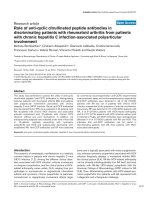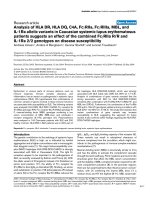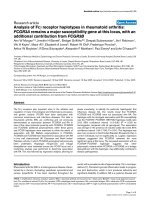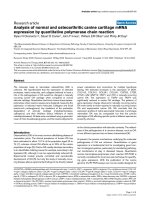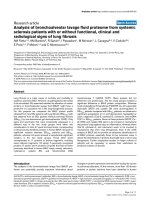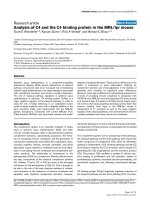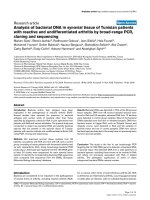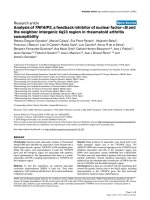Báo cáo y học: "Analysis of bronchoalveolar lavage fluid proteome from systemic sclerosis patients with or without functional, clinical and radiological signs of lung fibrosis" pot
Bạn đang xem bản rút gọn của tài liệu. Xem và tải ngay bản đầy đủ của tài liệu tại đây (872.39 KB, 11 trang )
Open Access
Available online />Page 1 of 11
(page number not for citation purposes)
Vol 8 No 6
Research article
Analysis of bronchoalveolar lavage fluid proteome from systemic
sclerosis patients with or without functional, clinical and
radiological signs of lung fibrosis
AM Fietta
1,4
, AM Bardoni
2
, R Salvini
2
, I Passadore
1
, M Morosini
1
, L Cavagna
3,4
, V Codullo
3,4
,
E Pozzi
1,4
, F Meloni
1,4
and C Montecucco
3,4
1
Department of Haematological, Pneumological and Cardiovascular Sciences, University of Pavia, Via Taramelli 5, 27100 Pavia, Italy
2
Department of Biochemistry, University of Pavia, Via Taramelli 5, 27100 Pavia, Italy
3
Department of Internal Medicine, University of Pavia, Via Taramelli 5, 27100 Pavia, Italy
4
IRCCS San Matteo, Piazzale Golgi 2, 27100 Pavia, Italy
Corresponding author: AM Fietta,
Received: 7 Mar 2006 Revisions requested: 21 Apr 2006 Revisions received: 31 May 2006 Accepted: 17 Oct 2006 Published: 17 Oct 2006
Arthritis Research & Therapy 2006, 8:R160 (doi:10.1186/ar2067)
This article is online at: />© 2006 Fietta et al.; licensee BioMed Central Ltd.
This is an open access article distributed under the terms of the Creative Commons Attribution License ( />),
which permits unrestricted use, distribution, and reproduction in any medium, provided the original work is properly cited.
Abstract
Lung fibrosis is a major cause of mortality and morbidity in
systemic sclerosis (SSc). However, its pathogenesis still needs
to be elucidated. We examined whether the alteration of certain
proteins in bronchoalveolar lavage fluid (BALF) might have a
protective or a causative role in the lung fibrogenesis process.
For this purpose we compared the BALF protein profile
obtained from nine SSc patients with lung fibrosis (SSc
Fib+
) with
that obtained from six SSc patients without pulmonary fibrosis
(SSc
Fib-
) by two-dimensional gel electrophoresis (2-DE). Only
spots and spot-trains that were consistently expressed in a
different way in the two study groups were taken into
consideration. In total, 47 spots and spot-trains, corresponding
to 30 previously identified proteins in human BALF, showed no
significant variation between SSc
Fib+
patients and SSc
Fib-
patients, whereas 24 spots showed a reproducible significant
variation in the two study groups. These latter spots
corresponded to 11 proteins or protein fragments, including
serum albumin fragments (13 spots), 5 previously recognized
proteins (7 spots), and 4 proteins (3 spots) that had not been
previously described in human BALF maps, namely calumenin,
cytohesin-2, cystatin SN, and mitochondrial DNA
topoisomerase 1 (mtDNA TOP1). Mass analysis did not
determine one protein-spot. The two study groups revealed a
significant difference in BALF protein composition. Whereas
levels of glutathione S-transferase P (GSTP), Cu–Zn superoxide
dismutase (SOD) and cystatin SN were downregulated in
SSc
Fib+
patients compared with SSc
Fib-
patients, we observed a
significant upregulation of α1-acid glycoprotein, haptoglobin-α
chain, calgranulin (Cal) B, cytohesin-2, calumenin, and mtDNA
TOP1 in SSc
Fib+
patients. Some of these proteins (GSTP, Cu–
Zn SOD, and cystatin SN) seem to be involved in mechanisms
that protect lungs against injury or inflammation, whereas others
(Cal B, cytohesin-2, and calumenin) seem to be involved in
mechanisms that drive lung fibrogenesis. Even if the 2-DE
analysis of BALF did not provide an exhaustive identification of
all BALF proteins, especially those of low molecular mass, it
allows the identification of proteins that might have a role in lung
fibrogenesis. Further longitudinal studies on larger cohorts of
patients will be necessary to assess their usefulness as
predictive markers of disease.
Introduction
The analysis of the bronchoalveolar lavage fluid (BALF) pro-
teome can potentially provide important information about
changes in protein expression and secretion during the course
of pulmonary disorders. At the moment, more than 100 human
proteins or protein isoforms have been identified in human
Anti-Scl70 = anti-topoisomerase I antibodies; BAL = bronchoalveolar lavage; BALF = bronchoalveolar lavage fluid; Cal = calgranulin; 2-DE = two-
dimensional gel electrophoresis; GSTP = glutathione S-transferase P; HRCT = high-resolution computed tomography; IL = interleukin; IPG = immo-
bilized pH gradient; MAP = mitogen-activated protein; MS, mass spectrometry; mtDNA TOP1 = mitochondrial DNA topoisomerase 1; SOD = super-
oxide dismutase; SSc = systemic sclerosis; SSc
Fib-
= systemic sclerosis patients without lung fibrosis; SSc
Fib+
= systemic sclerosis patients with lung
fibrosis; TLCO = carbon monoxide transfer.
Arthritis Research & Therapy Vol 8 No 6 Fietta et al.
Page 2 of 11
(page number not for citation purposes)
BALF by using two-dimensional gel electrophoresis (2-DE),
including both proteins released locally in the lung by inflam-
matory or epithelial cells and proteins derived from serum by
diffusion across the capillary–alveolar barrier [1,2]. Previous
studies showed that the protein composition of BALF was
altered in sarcoidosis, idiopathic pulmonary fibrosis, allergic
asthma, and chronic obstructive pulmonary disease [3-5]. Fur-
thermore, Rottoli and colleagues [6] recently demonstrated
that systemic sclerosis patients with pulmonary fibrosis (SSc-
Fib+
) showed a BALF profile that was intermediate between
that of patients with sarcoidosis and idiopatic pulmonary fibro-
sis, despite some particularities.
Systemic sclerosis (SSc) is an autoimmune disorder of
unknown origin, characterized by an excessive deposition of
collagen and other extracellular matrix proteins on the skin as
well as multiple internal organs, alterations in microvascula-
ture, and humoral and cellular abnormalities [7]. Clinically, the
disease is very heterogeneous, ranging from limited skin
involvement with limited systemic alterations to clinical pic-
tures with diffuse skin sclerosis and severe visceral involve-
ment with fibrosis, microvascular abnormalities and
mononuclear cell infiltration of the gastrointestinal tract, lungs,
heart, and kidneys. Pulmonary involvement has emerged as
potentially the most serious visceral lesion in SSc. Alveolitis is
more commonly seen in SSc with diffuse skin sclerosis, partic-
ularly in the presence of serum anti-topoisomerase I (anti-
Scl70) antibodies, but only 15% of patients eventually reach
severe end-stage lung fibrosis [8].
Given the complexity of the pathogenesis of lung fibrosis and
the lack of biological markers that can reliably predict which
patients will evolve the disease, great interest has been shown
in these issues, also comparing cohorts of SSc patients with
or without lung involvement. The ability to identify the proteins
that are differently expressed in the lower airways of SSc
Fib+
patients from those in SSc
Fib-
patients might provide new
insight into the disease pathogenesis and into the identifica-
tion of possible protein biomarkers of the disease's progres-
sion. With this aim, we used the 2-DE analysis to assess and
compare the protein profile of BALFs from a group of SSc
Fib+
and SSc
Fib-
patients, respectively.
Materials and methods
Patients
The samples consisted of archived BALF samples acquired
between March 2004 and April 2005 from 15 SSc patients
who satisfied the preliminary American College of Rheumatol-
ogy criteria for disease classification [9]. All the patients were
female and non-smoker outpatients at the Rheumatology Unit
of the Policlinico San Matteo, Pavia, Italy. They all gave their
informed consent to undergo bronchoscopy, and none were
being treated with prednisone or other immunosuppressive
agents at the time of enrollment. Five patients had SSc with
limited skin involvement and 10 had SSc with diffuse skin scle-
rosis; indirect immunofluorescence on Hep-2 cells detected
the antinuclear antibodies, and the anti-Scl70 antibodies were
evaluated by enzyme-linked immunosorbent assay (Diamedix
Co., Miami, FL, USA). All the patients tested positive for anti-
nuclear antibodies, and nine had anti-Scl70 antibodies.
The diagnosis of SSc-associated lung fibrosis was based on
clinical, functional and radiographic signs. In all the cases, car-
bon monoxide transfer, forced vital capacity, chest radiogra-
phy, and high-resolution computed tomography (HRCT)
determined the respiratory involvement, which was defined as
at least a grade 1 severity on the disease severity scale for
SSc [10]. In all the cases, the same expert radiologist calcu-
lated the Kazerooni score for fibrosis as described previously
[11]. Nine patients showed a decrease of at least 20% with
regard to the expected carbon monoxide transfer or forced
vital capacity values [12]. This decrease was associated with
abnormal chest radiograph and the presence of significant
fibrosis on the HRCT scan (mean Kazerooni fibrosis score: 10
± 5 SD). These nine patients were included in the SSc
Fib+
group. The remaining six patients, who revealed no evidence
of lung involvement either on the lung function tests or on the
HRCT scan (absence of fibrosis and/or a ground-glass pat-
tern), were included in the SSc
Fib-
group. Table 1 details the
patients' demographic, clinical, immunological and functional
characteristics.
Bronchoalveolar lavage and phenotype analysis
Bronchoalveolar lavage (BAL) was performed as described
previously [13]. To summarize briefly, the distal tip of the bron-
choscope was wedged into the middle lobe or lingular bron-
chus. A total of 150 ml of warm sterile saline solution were
instilled in 30 ml aliquots and serially recovered by gentle aspi-
ration. The first collected aliquot was used for the microscopic
and cultural examination of common bacteria and fungi, and of
direct acid-fast bacilli smears (Kinyoun method) and cultures
for mycobacteria, and for the microscopic examination of
Pneumocystis jiroveci (Gomori-Grocott silver stain). All the
other aliquots were used to assess the total and differential
cell counts (performed on cyto-centrifuged preparations with
the use of May–Grünwald–Giemsa and Papanicolaou stain-
ings) and the percentages of CD4
+
and CD8
+
T cells
(assessed by cytofluorimetry). Samples were immediately fil-
tered twice through gauze, then centrifuged at 1,500 r.p.m. for
10 min, and BALF samples were promptly frozen in aliquots
and stored at -80°C until used.
Two-dimensional gel electrophoresis
BALF samples were dialyzed (tubing cut-off 1 kDa) for a few
days against several changes of distilled water, in the pres-
ence of protease inhibitors (protease inhibitor cocktail; Sigma,
St Louis, MO, USA), and the protein content was assessed
(bicinchoninic acid protein assay kit; Pierce, Rockford, IL,
USA). Samples were freeze-dried and pellets were suspended
in 8 M urea, 4% w/v CHAPS, 65 mM 1,4-dithioerythritol (solu-
Available online />Page 3 of 11
(page number not for citation purposes)
tion A). Two-dimensional gel electrophoresis was performed
as described previously [14]. In brief, for each analytical exper-
iment the same amount (70 μg) of proteins was loaded on
immobilized pH gradient (IPG) strips (pH 3.5 to 10, 18 cm;
Amersham Biosciences, Uppsala, Sweden), which were swol-
len in solution A plus 0.8% carrier ampholytes (Ampholine™,
pH 3.5 to 10 for IEF; Amersham Biosciences) and a trace of
bromophenol blue. A larger amount of protein (1 mg) had to be
loaded for identification by mass spectrometry (MS). Rehydra-
tion was performed in the strip holder of the IPGphor system
at 20°C (Amersham Biosciences) and isoelectrofocusing was
terminated at 60 kV h. The IPG strips were equilibrated first for
12 minutes in urea/SDS/Tris buffer, and then in the same
buffer containing 2.5% (w/v) iodoacetamide. The run in the
second dimension was performed on 9 to 16.5% polyacryla-
mide linear gradient gels with a constant current of 40 mA per
gel at 10°C. The gels were stained with ammoniacal silver
nitrate or colloidal Coomassie G-250 [15].
Evaluation and protein identification
The Versadoc Imaging System Model 3000 (Bio-Rad, Rich-
mond, CA, USA) scanned the gels, which the PD QUEST 7.1
software (Bio-Rad) then analyzed. The total number of spots,
the non-matched spots and the spot parameters were meas-
ured. To detect differentially expressed protein spots in SSc-
Fib+
compared with those in SSc
Fib-
patients, the software was
instructed to create one reference map for each patient group.
The software established these maps by taking into account
only the spots that were constantly expressed in each patient
of the same group. At least two gels from each patient were
evaluated. Initially, we compared the two reference maps so as
to assess differences in spot quantity between the two study
groups. The PD QUEST 7.1 software determined the spot
quantity by formula: Spot height × π × σ
x
× σ
y
(where the spot
height represented the peak of the spot's Gaussian represen-
tation, and σ
x
and σ
y
were the SD of the spot's Gaussian dis-
tribution in the directions of the x and y axes, respectively)
normalized the value for the total protein content of each gel.
The differences between the two study groups were then con-
firmed by analysing the spot quantities observed in single
patients. On the basis of the recent guidelines for proteomics
research [16], non-matched spots and spots that differed sig-
nificantly in quantity (p < 0.05) were regarded as differentially
expressed in SSc
Fib+
compared with SSc
Fib-
patients.
Proteins were identified by comparing the BALF maps
obtained in this study with the SWISS-2D PAGE human
plasma map [17] and published BALF maps [5,6], using
immunoblotting, matrix-assisted laser desorption/ionization
MS, and/or liquid chromatography MS/MS. For the MS analy-
sis, the selected spots, excised from Coomassie-stained gels,
were analyzed in a Voyager DE-PRO mass spectrometer
(Applied Biosystems, Foster City, CA, USA), equipped with a
reflectron analyzer and used in delayed extraction mode. Mass
signals were used for database searching with the MASCOT
peptide fingerprinting search program (Matrix Science, Bos-
ton, MA, USA). A quadrupole time-of-flight. Ultima hybrid mass
spectrometer (Micromass, Toronto, Ontario, Canada) was
Table 1
Demographic, clinical, immunological and functional characteristics of scleroderma patients
Characteristic SSc
Fib+
SSc
Fib-
Number 96
Age, years (mean ± SD) 55.6 ± 10.3 50.5 ± 9.6
Cutaneous involvement
Lc SSc (percentage) 1 (11.1) 4 (66.7)
Dc SSc (percentage) 8 (89.9) 2 (33.3)
Skin score (mean ± SD) 17.0 ± 8.0 10.0 ± 6.0
Autoantibodies
ANA positive (percentage) 9 (100) 6 (100)
Anti-Scl70 positive (percentage) 7 (77.7) 2 (33)
Lung function test
FVC, percentage predicted (mean ± SD) 80.9 ± 11.7
a
118.7 ± 11.6
TLCO, percentage predicted (mean ± SD) 60.01 ± 12.6
a
72.03 ± 13.8
Kazerooni score 10.0 ± 5 0
Skin score and Kazerooni score for fibrosis were determined as described previously [9,11]. SSc
Fib+
, systemic sclerosis patients with functional
lung fibrosis and signs of lung fibrosis on high-resolution computed tomography; SSc
Fib-
, SSc patients with no signs and symptoms of lung
involvement; Lc SSc, limited cutaneous SSc; Dc SSc, diffuse cutaneous SSc; ANA, antinuclear antibodies; anti-Scl70, anti-topoisomerase I
antibodies; FVC, forced vital capacity; TLCO, carbon monoxide transfer.
a
Decrease more than 20% with regard to the expected TLCO or FVC
values.
Arthritis Research & Therapy Vol 8 No 6 Fietta et al.
Page 4 of 11
(page number not for citation purposes)
used for the liquid chromatography–MS/MS analysis. The
instrument was set up in a data-dependent MS/MS mode, and
the raw MS and MS/MS spectra were elaborated with Protein-
Lynx software. The MASCOT MS/MS ion search software for
protein identification was used. These evaluations were per-
formed at CEINGE Biotecnologie Avanzate s.c. a r.l., Univer-
sity Federico II, Naples, Italy).
Statistical methods
Results are presented as mean ± SD or median and interquar-
tile range. Normally distributed variables were analyzed by a
two-tailed Student's t test. Proteomics expression data were
compared by using the Mann–Whitney U test. For all tests p
< 0.05 was regarded as significant. Analyses were performed
with PRISM 3.0 (GraphPad Software, San Diego, CA, USA).
Results
BAL was performed in 15 SSc patients, including 9 patients
with clinical, functional and HRCT signs of interstitial lung
fibrosis (SSc
Fib+
patients) and 6 patients who had no signs
and symptoms of lung involvement (SSc
Fib-
patients). No clini-
cal or microbiological evidence of bacterial or fungal infections
was ever found in the included patients. Furthermore, the two
patient groups revealed no significant difference in total BAL
cells recovered, CD4
+
/CD8
+
T-cell ratio, protein content, or
differential BAL cell counts, although the SSc
Fib+
patients dis-
played a trend toward higher neutrophil and eosinophil counts
(Table 2). Neutrophil and eosinophil counts, as expected, were
significantly higher in the SSc
Fib+
patients than in data
obtained in our laboratory from a group of healthy volunteers
[12].
BALF proteome in SSc
Fib+
and SSc
Fib-
patients
Two-dimensional gel electrophoresis analyzed the whole pro-
tein profile of BALF from SSc
Fib+
and SSc
Fib-
patients, to eval-
uate possible differences in protein expression between the
two states of the disease. The mean number of spots, of which
several were organized as spot-trains, in gels of BALF from
SSc
Fib+
and SSc
Fib-
patients was 365 ± 84 and 390 ± 75,
respectively. However, only 332 and 348 of these spots were
constantly expressed in BALF from all single SSc
Fib+
and SSc-
Fib-
patients, respectively. Figure 1 shows a representative
Coomassie-stained gel map from an SSc
Fib+
patient (Figure
1a) and an SSc
Fib-
patient (Figure 1b). By comparing the quan-
tity of 59 individual spots and 12 spot-trains, we identified 35
spots and 12 spot-trains whose quantity did not vary signifi-
cantly between SSc
Fib+
and SSc
Fib-
patients (Mann–Whitney
U test p > 0.05). By matching these gel maps with published
two-dimensional BALF maps, we identified 30 proteins corre-
sponding to the 47 spots and spot-trains that did not vary in
quantity between the two patient groups (Table 3). Immunob-
lotting also validated the assignment of some of these pro-
teins. Furthermore, we detected 24 individual spots that
showed a reproducible, significant variation between the two
study groups. The quantity in 21 of these spots was signifi-
cantly increased, whereas the quantity in 3 spots was signifi-
cantly decreased in SSc
Fib+
patients compared with SSc
Fib-
patients.
Matrix-assisted laser desorption/ionization MS with or without
liquid chromatography–MS/MS analysis identified the pro-
teins corresponding to 21 spots that were constantly and sig-
nificantly expressed in a different way between the two study
groups. A comparison with published two-dimensional BALF
maps followed by immunoblotting validation identified the pro-
teins corresponding to the remaining three spots with the
aforementioned criteria (Table 4). These 24 differently
expressed spots corresponded to 11 proteins/protein frag-
ments in total: 13 spots corresponded to serum albumin frag-
ments, 7 of them corresponded to 5 previously recognized
BALF proteins (α1-acid glycoprotein (2 spots), haptoglobin-α
chain (2 spots), calgranulin (Cal) B, Cu–Zn superoxide dis-
mutase (SOD) and glutathione S-transferase P (GSTP)), and
3 spots corresponded to 4 proteins that, to our knowledge,
had not previously been described in published BALF two-
dimensional maps (calumenin and cytohesin-2 (1 spot), cysta-
Table 2
Cytology, CD4
+
/CD8
+
T-cell ratio and protein contents of bronchoalveolar lavage samples
Parameter SSc
Fib+
(n = 9) SSc
Fib-
(n = 6) Controls (n = 9)
Total BAL cells (10
5
/ml) 2.05 ± 1.13 1.80 ± 0.74 2.02 ± 1.33
Macrophages (percentage) 84.97 ± 8.66 87.73 ± 5.12 85.78 ± 7.09
Lymphocytes (percentage) 8.01 ± 4.15 7.80 ± 2.63 12.33 ± 6.36
Neutrophils (percentage) 4.44 ± 4.03
a
2.76 ± 1.98 1.56 ± 1.59
Eosinophils (percentage) 2.62 ± 3.66
a
0.83 ± 0.60 0.33 ± 0.70
CD4
+
/CD8
+
ratio 2.30 ± 1.02 2.14 ± 1.16 2.4 ± 0.71
Protein concentration (μg/ml) 130.44 ± 53.76 133.43 ± 32.38 ND
Results are given as mean ± SD. SSc
Fib+
, systemic sclerosis patients with functional lung fibrosis and signs of lung fibrosis on high-resolution
computed tomography; SSc
Fib-
, SSc patients with no signs and symptoms of lung fibrosis. Control values are taken from data previously assessed
in a group of healthy volunteers [12]. BAL, bronchoalveolar lavage; ND, not determined.
a
p < 0.05 compared with controls (all assessed by
Student's t test).
Available online />Page 5 of 11
(page number not for citation purposes)
tin SN and a fragment of mtDNA TOP1). One protein spot was
marked as not determined because its identification gave a
score that indicated uncertain identification. SSc
Fib+
patients
showed a significant upregulation of α1-acid glycoprotein,
haptoglobin-α chain, Cal B, calumenin, and cytohesin-2 levels
compared with SSc
Fib-
patients. Furthermore, the expression
of a fragment of mtDNA TOP1 was exclusively detectable in
SSc
Fib+
patients, including two patients who were negative for
anti-Scl70 serum antibodies. Finally, whereas Cu–Zn SOD
was significantly downregulated, GSTP and cystatin SN were
not detectable in SSc
Fib+
patients in contrast with SSc
Fib-
patients.
Discussion
The pathogenesis of SSc is extremely complex, and no single
unifying hypothesis or pathogenetic mechanism can explain all
the aspects of this disease. It is therefore widely accepted that
functional alterations of several cell effectors, including fibrob-
lasts, endothelial cells, and T and B lymphocytes, are intimately
involved in the development of the clinical and pathological
manifestations of SSc [7,18,19]. Abnormalities in lung func-
tion occur in about 70% of SSc patients and currently repre-
sent the main cause of mortality in this population [7].
However, the factors that drive the severe and progressive vis-
ceral fibrosis remain mostly undetermined. Unlike the recent
pathogenetic hypothesis for idiopathic interstitial lung fibrosis,
which assigns only a marginal role to inflammation, fibrogene-
sis in SSc-related lung involvement is generally thought to be
the result of a complex series of interstitial immunoinflamma-
tory reactions [20]. The persistent and unregulated activation
of genes that encode various collagen and other extracellular
matrix proteins is regarded as a crucial pathogenetic event
[21,22]. Furthermore, an alteration in the production of pro-
inflammatory and/or pro-fibrotic cytokines and chemokines,
growth factors (in particular transforming growth factor-β), and
signaling molecules also seems to have a relevant role in fibro-
genesis [23,24]. The identification of proteins that are differ-
ently expressed in the airways of SSc
Fib+
patients compared
with patients with no signs or symptoms of lung involvement
may cast light on the pathogenetic mechanism of the disease
and may thereby indicate protein biomarkers that are useful for
the diagnosis of lung involvement, for the monitoring of SSc
progression, and for the identification of possible new thera-
peutic targets. In this context, the use of 2-DE and the map-
ping of BALF seem highly interesting.
Our results demonstrated that quantitative and qualitative dif-
ferences can be found between patients with SSc-associated
lung fibrosis and patients with SSc with no signs or symptoms
of lung involvement. At least 24 well-defined spots showed
significant and reproducible variations in relative abundance
between the two patient groups. Some of these spots corre-
sponded to previously described BALF proteins and protein
fragments, namely α1-acid glycoprotein, GSTP, Cu–Zn SOD,
haptoglobin-α chain, and calgranulin B, whereas 4 of the pro-
teins found had not previously been described in published
two-dimensional BALF maps, namely cytohesin-2, calumenin,
cystatin SN, and human mtDNA TOP1 fragment. In SSc
Fib+
patients, GSTP and cystatin SN were below the detection
limit, whereas Cu–Zn SOD was downregulated. In contrast,
α1-acid glycoprotein, calumenin, cytohesin-2, haptoglobin-α
chain, and calgranulin B were significantly upregulated, and
the expression of mtDNA TOP1 was observed only in SSc
Fib+
patients.
On the basis of these preliminary results, we can infer that 2-
DE analysis of BALF can provide useful insight into the under-
standing of mechanisms involved in lung fibrogenesis through
the identification of proteins that are deregulated in SSc-asso-
ciated lung fibrosis. However, our results, as well as those of
previous studies, clearly indicated that 2-DE analysis did not
provide an exhaustive identification of all proteins that can be
present in BALF, especially those of low molecular mass such
as cytokines, chemokines, growth factors, and signaling mole-
cules. Because these molecules are thought to be relevant to
the pathogenesis of SSc-associated lung fibrosis, a combina-
tion of 2-DE analysis and proteomic approaches that specifi-
cally address the identification of these factors is necessary for
the assessment of the whole protein pattern of BALF. Despite
these considerations, most of the proteins we found differently
regulated between SSc
Fib+
patients and SSc
Fib-
patients could
have a role in the development of lung fibrosis, whereby some
of them are involved in the mechanisms that protect against
lung injury or inflammation whereas others are involved in the
mechanisms that drive fibroproliferation.
Oxidative stress is believed to be important in the pathogene-
sis of lung damage and in the development of lung fibrosis
[25]. Among various enzymatic and non-enzymatic mecha-
nisms that protect cells and tissues from oxidants [26,27], glu-
tathione transferases [28] and SODs [29] are among such
mechanisms that are thought to have a key protective role,
especially in the lung. High levels of extracellular SODs are
thought to have a protective role for lung matrix [29]. Recently,
Tourkina and colleagues [30] demonstrated a deficiency in
GSTP1 in scleroderma lung fibroblasts. The observation that
GSTP and Cu–Zn SOD levels are severely downregulated in
BALF from SSc
Fib+
patients is in line with these findings, and
confirms the relevance of these molecules as a defense tool
for the lung against oxidant-induced damage and/or fibropro-
liferation.
Moreover, in BALF from SSc
Fib+
patients, we did not detect
levels of cystatin SN, which was, in contrast, well represented
in SSc
Fib-
patients. Cystatin SN is a secreted protein, which
belongs to SD-type or type-2 cystatins [31], which are potent
inhibitors of CA clan mammalian cysteine peptidases. Intracel-
lularly, these enzymes participate in normal protein turnover, in
antigen and protein processing, and in apoptosis, whereas
extracellularly they are involved in the inhibition of the proteo-
Arthritis Research & Therapy Vol 8 No 6 Fietta et al.
Page 6 of 11
(page number not for citation purposes)
Figure 1
Representative Coomassie-stained gels of bronchoalveolar lavage fluidRepresentative Coomassie-stained gels of bronchoalveolar lavage fluid. Samples shown were taken from a systemic sclerosis patient with lung fibro-
sis (SSc
Fib+
) (a) and a systemic sclerosis patient without lung fibrosis (SSc
Fib-
) (b). Analyzed spots are marked with a number and the corresponding
identified proteins are listed in Tables 3 and 4. Proteins whose expression was significantly different between SSc
Fib+
patients and SSc
Fib-
patients
are also indicated by name.
Available online />Page 7 of 11
(page number not for citation purposes)
lytic cascade [32]. The direct inhibition of endogenous and
exogenous cysteine peptidases is the only function described
so far for cystatin SN, suggesting that its function is to protect
tissues against injury induced by these enzymes. However,
recent results obtained with other type-2 cystatins seem to
suggest a broader spectrum of activities, including the upreg-
ulation of IL-6 by human gingival fibroblasts, interferon-γ
expression in CD4
+
T cells [33,34], and the involvement in the
differentiation and maturation of human dendritic cells [35].
Furthermore, we found an upregulation of at least six proteins
in BALF from SSc
Fib+
patients: haptoglobin-α chain, α1-acid
Table 3
Proteins whose quantity in BALF did not significantly vary between SSc
Fib+
and SSc
Fib-
patients
Spot no. Protein Identification method
11β glycoprotein GM
2Hemopexin GM
3 Transferrin GM
4Albumin GM
5 Ig heavy chain α GM
6 Vitamin D-binding protein GM
7 α1-antitrypsin GM, Ab
8 α1-antichymotrypsin GM, Ab
9 α1-HS-glycoprotein GM
10 Leucin-rich α2-glycoprotein GM
11 Fibrinogen γ A chain GM, Ab
12 Ig heavy chain γ GM
14 Haptoglobulin 1β chain GM
15 Pulmonary surfactant-associated protein A GM
16 Apolipoprotein A1 GM, Ab
17 Ig light chain κ, λ GM, Ab
18 Serum retinol-binding protein GM
20 Transthyretin GM, Ab
21 Immunoglobulin-binding factor GM
22 Calgranulin A GM
23 Hemoglobin β chain GM
24 ERP60 (protein disulfide isomerase) GM, Ab
25 α1-antitrypsin (fragment) GM, Ab
26 Ig J chain GM
27 C-reactive protein GM
28–30 Apolipoprotein A1 (fragment) GM, Ab
31 Calcyphosine GM
32 TCTP (translationally controlled tumor protein) GM
33 ATP synthase δ chain mitochondrial GM
34 L-FABP (liver fatty acid-binding protein) GM
Spot quantity was assessed by PDQUEST 7.1 software on two BALF gel maps of individual SSc
Fib+
(n = 9) and SSc
Fib-
(n = 6) patients. Spot
quantity between SSc
Fib+
and SSc
Fib-
patients did not differ significantly (Mann–Whitney U test, p > 0.05). Spot no. refers to the annotations in
Figure 1. BALF, bronchoalveolar lavage fluid; SSc
Fib+
, systemic sclerosis patients with functional lung fibrosis and signs of lung fibrosis on high-
resolution computed tomography; SSc
Fib-
, SSc patients with no signs and symptoms of lung fibrosis; GM, gel matching with plasma two-
dimensional gel electrophoresis database from Swiss-PROT [17] and published two-dimensional gel electrophoresis BALF maps [5,6]; Ab,
immunoblotting.
Arthritis Research & Therapy Vol 8 No 6 Fietta et al.
Page 8 of 11
(page number not for citation purposes)
glycoprotein, calumenin, cytohesin-2, Cal B, and mtDNA
TOP1.
Haptoglobin and α1-acid glycoprotein are positive acute-
phase proteins, whose plasma concentrations increase during
inflammation [36]. The increased levels of both proteins in
BALF from SSc
Fib+
patients is likely to originate from the pas-
sive diffusion from plasma, as a result of the increased perme-
ability of the air–blood barrier during the course of fibrosing
alveolitis.
Calumenin is a member of the CREC family [37] that is
secreted into the medium of cultured cells including fibrob-
lasts [38] and early melanosomes [39]. Intracellularly, calu-
menin has a chaperone function in several Ca
2+
-regulated
processes, but extracellularly its function is not yet fully under-
stood. Vorum and colleagues found that calumenin binds to
the serum amyloid P component, suggesting that it is involved
in the formation of amyloid deposits in different tissues [40].
Coppinger and colleagues recently described the presence of
calumenin in platelets and its release on platelet activation, as
well as the protein's presence in human atherosclerotic
lesions [41], therefore suggesting a possible role of this pro-
tein in leading to vascular injury through the promotion of plate-
let adhesion, fibrinogenesis, and intravascular thrombus
deposition. Taking into account that a crucial pathogenetic
step in SSc involves injury to microvasculature [19,20], it is
possible to infer that calumenin could have a role in taking
such an injury to lung level.
Cytohesin-2 is a member of a family of cytoplasmic signaling
proteins [42], which may move from the cytosol to the plasma
membrane after cell stimulation [43]. Although its biological
function is mostly unknown, a recent study demonstrated that
cytohesin-2 is an activator of the mitogen-activated protein
(MAP) kinase signaling pathway [44]. Because MAP kinases
are activator signals for lung fibroblasts [23], we suggest that
cytohesin-2 might participate in the development and/or pro-
gression of lung fibrosis in SSc patients through the activation
of the MAP kinase signaling pathways in lung fibroblasts. This
hypothesis needs to be verified with further experimental
observations.
Calgranulin B is an S100 protein that is unique together with
Cal A in its myeloid-specific expression profile and in its abun-
dance in neutrophils [45]. Increased levels of Cal B are
present in the bronchial secretion of patients with chronic
inflammatory disease, and these levels may induce the produc-
Table 4
BALF proteins whose regulation in SSc
Fib+
and SSc
Fib-
patients is different
Spot no. Median (IQR) spot quantity Protein or fragment MW (kDa) pI AC Identification
method
SSc
Fib+
SSc
Fib-
p
13 328.0 (256.5–482.5) 86.0 (68.6–110.4) 0.0003 α1-acid glycoprotein (orosomucoid) 23.5 4.93 P02763 GM (plasma,
BALF), Ab
19 7.9 (5.6–9.6) 28.2 (24.5–32.6) Cu–Zn superoxide dismutase 15.8 5.70 P00441 GM (plasma,
BALF), Ab
35 343.0 (328.5–664.0) 168.0 (131.5–267.0) 0.0041 Serum albumin
a
69.4 5.92 P02768 MS
36 96.6 (68.9–127.6) 24.4 (17.2–64.5) 0.0012 Calgranulin B (S100A9; MRP14) 13.2 5.71 P06702 MS, GM (plasma,
BALF)
37 53.3 (47.4–72.1) 11.1 (8.0–22.9) 0.0001 Haptoglobin (Hp2) α chain
a
15.9 5.57 P00738 MS, LC, GM
(plasma, BALF)
38 Not expressed 32.0 (29.5–39.0) Glutathione S transferase P 23.2 5.44 P09211 MS, GM (plasma,
BALF)
39 59.1 (50.8–73.1) 14.8 (9.4–19.6) 0.0014 Cytohesin-2
a,b
46.5 5.43 Q99418 MS, LC MS, LC
Calumenin
a,b
37.1 4.47 O43852 MS, LC MS, LC
40 29.2 (25.5–30.8) Not expressed Mitochondrial DNA topoisomerase 1
a,b
69.8 9.46 Q969P6 MS, LC
41 Not expressed 45.5 (32.2–58.9) Cystatin SN
b
16.3 6.82 P01037 MS, LC
42 Not expressed 37.7 (34.0–41.0) Not determined - - - (MS, LC)
Spot quantity values were measured on two BALF gel maps of individual SSc
Fib+
(n = 9) and SSc
Fib-
(n = 6) patients by PDQUEST 7.1 software.
Results are expressed as median and interquartile range (IQR). Spot no. refers to the annotations in Figure 1; p values were calculated with the
Mann–Whitney U test. BALF, bronchoalveolar lavage fluid; SSc
Fib+
, systemic sclerosis patients with functional lung fibrosis and signs of lung
fibrosis on high-resolution computed tomography; SSc
Fib-
, SSc patients with no signs and symptoms of lung fibrosis; MW, theoretical average
molecular mass; pI, isoelectric point; AC, accession number from the Swiss-PROT 2DPAGE database [17]; GM, gel matching with plasma two-
dimensional gel electrophoresis database from Swiss-PROT [17] and published BALF two-dimensional gel electrophoresis maps [5,6]; Ab,
immunoblotting; MS, matrix-assisted laser desorption/ionization mass spectrometry analysis; LC, liquid chromatography–tandem mass
spectrometry analysis.
a
Fragments.
b
Proteins not previously described in published BALF two-dimensional gel electrophoresis maps.
Available online />Page 9 of 11
(page number not for citation purposes)
tion of IL-8 by airway epithelial cells [46]. Furthermore, Vie-
mann and colleagues demonstrated that the expression of Cal
B and Cal A correlates with the inflammatory activity in sys-
temic vasculitis, thereby confirming the role of these proteins
in inflammatory reactions of endothelia [47]. Although the gen-
eral consensus is that the Cal B function depends mainly on
heterodimer formation (Cal B–Cal A), several studies have
demonstrated that the monomer is also a potent stimulator of
neutrophils and is involved in the recruitment of leukocytes to
the site of inflammation through the regulation of adhesion and
the extravasion of neutrophils [45,48]. Furthermore, recom-
binant Cal B and its homodimer stimulate the proliferation of
rat fibroblasts, suggesting that this protein might also function
as a mitogen for fibroblasts in chronic inflammation [49]. On
the basis of these observations, Cal B could have a role in
SSc-associated lung fibrosis through several pathways,
including amplifying the inflammatory process by inducing the
extravasion of neutrophils and the production of IL-8, inducing
an inflammatory reaction in the endothelia, and/or stimulating
lung fibroblast proliferation.
Finally, we found that a fragment of mtDNA TOP1 was detect-
able only in BALF from patients with interstitial lung fibrosis,
including in two SSc
Fib+
patients who were negative for serum
anti-Scl70 antibodies. This protein fragment was never
observed in BALF from SSc
Fib-
patients, including in two
patients with positive anti-Scl70 antibodies. A common 13-
exon motif and a similar amino-acid sequence characterize
genes for mitochondrial and nuclear DNA TOP1, except for
the N-terminal domain, which in mtDNA TOP1 contains a mito-
chondrial localization sequence instead of the nuclear localiza-
tion signal [50]. Although we demonstrated that the presence
of detectable levels of mtDNA TOP1 was a constant and par-
ticular feature of SSc
Fib+
patients, we did not fully ascertain the
antigenic role of this protein fragment and its relation with the
development of lung fibrosis. Because autoantibodies against
DNA TOP1 are strongly correlated with interstitial pulmonary
involvement in SSc [51], further studies are warranted to
assess the role and the frequency of this antigenic target in
BALF.
Conclusion
On the basis of these preliminary results we believe that the
comparative analysis of BALF proteome from SSc
Fib+
and
SSc
Fib-
patients by 2-DE might provide a useful insight into
some relevant steps of lung fibrogenesis. SSc-associated lung
Figure 2
Hypothetical role of some disregulated BALf proteins in mechanisms driving SSc-related lung fibrosisHypothetical role of some disregulated BALf proteins in mechanisms driving SSc-related lung fibrosis. Inflammation is thought to be the main mech-
anism driving lung fibrosis in scleroderma patients. In this complex inflammatory process several pathways are involved, including the activation of T
cells and epithelial cells, the secretion of pro-inflammatory cytokines and growth factors, and fibroblast proliferation. Furthermore, products from the
coagulation cascade and oxidative stress may contribute to fibrogenesis. The upregulation of calgranulin B (Cal B), cytohesin-2 and calumenin might
favor inflammation and fibrogenesis, whereas the downmodulation of the protective factors glutathione S-transferase P (GSTP), Cu–Zn superoxide
dismutase (SOD) and cystatin SN may amplify tissue injury and inflammation. MMP, matrix metalloproteinases; TIMP, tissue inhibitor of matrix metal-
loproteinases; ROS, reactive oxygen species; RNS, reactive nitrogen species; O
2
-
, superoxide; H
2
O
2
, hydrogen peroxide; NO, nitric oxide; SSc
Fib+
,
systemic sclerosis patients with lung fibrosis; SSc
Fib-
, systemic sclerosis patients without lung fibrosis.
Arthritis Research & Therapy Vol 8 No 6 Fietta et al.
Page 10 of 11
(page number not for citation purposes)
fibrosis is a multifaceted process involving the activation of T
cells and epithelial cells, the secretion of pro-inflammatory
cytokines and growth factors, and fibroproliferation (Figure 2).
In addition, several factors, including activation of the coagula-
tion cascade and oxidative stress, are thought to influence the
development of lung fibrosis. At least six proteins that were dif-
ferently regulated in BALF from SSc
Fib+
patients and in BALF
from SSc
Fib-
patients might have a role in the pathogenesis of
SSc-associated interstitial lung disease. As shown in Figure 2,
the upregulation of Cal B, cytohesin-2, and calumenin in BALF
from SSc
Fib+
patients could further promote the synthesis of
pro-inflammatory cytokines, the influx of inflammatory cells,
and fibrinogenesis, whereas the downregulation of GSTP,
Cu–Zn SOD and cystatin SN could favor vascular and lung tis-
sue injury through the impairment of mechanisms that protect
against oxidants and cysteine peptidases. However, further
animal and human studies will be necessary both to assess the
actual role of each of these factors in the development of SSc-
associated lung fibrosis and to determine whether these fac-
tors are relevant as disease biomarkers, and if so which ones.
Conclusions from these studies could enable us to predict
which patients will develop progressive pulmonary fibrosis.
Competing interests
The authors declare that they have no competing interests.
Authors' contributions
FAM generated and planned the project, supervised the work
and wrote the manuscript. BAM and SR contributed equally to
perform the research, analyzed critically data and participated
in the preparation of the manuscript. PI assisted in designing
the experiments and conducted 2-DE and immunoblotting.
MM was involved in data analysis and performed statistical
analysis. CL and CV selected patients and revised all clinical
charts. PE was involved in the coordination of the study and in
the discussion and revision of the manuscript. MF participated
in the study design, supervised the work, read the bronchoal-
veolar lavage and helped to draft the manuscript. MC partici-
pated in the study design and its coordination and participated
in preparation of the manuscript. All authors read and
approved the final manuscript.
Acknowledgements
We thank Dr Angela Flagiello for help with mass analysis, and Professor
Piero Pucci for insightful comments on the manuscript. This work was
supported by Fondazione Cariplo, Italy (Grant Rif.2003.1644/10.8485).
References
1. Wattiez R, Hermans C, Bernard A, Lesur O, Falmagne P: Human
bronchoalveolar lavage fluid: two-dimensional gel electro-
phoresis, amino acid microsequencing and identification of
major proteins. Electrophoresis 1999, 20:1634-1645.
2. Wattiez R, Hermans C, Cruyt C, Bernard A, Falmagne P: Human
bronchoalveolar lavage fluid protein two-dimensional data-
base: study of interstitial lung diseases. Electrophoresis 2000,
21:2703-2712.
3. Magi B, Bini L, Perari MG, Fossi A, Sanchez JC, Hochstrasser D,
Paesano S, Raggiaschi R, Santucci A, Pallini V, et al.: Bronchoal-
veolar lavage fluid protein composition in patients with sar-
coidosis and idiopathic pulmonary fibrosis: a two-dimensional
electrophoretic study. Electrophoresis 2002, 23:3434-3444.
4. Sabounchi-Schutt F, Astrom J, Hellman U, Eklund A, Grunewald J:
Changes in bronchoalveolar lavage fluid proteins in sarcoido-
sis: a proteomics approach. Eur Respir J 2003, 21:414-420.
5. Wattiez R, Falmagne P: Proteomics of bronchoalveolar lavage
fluid. J Chromatogr B Analyt Technol Biomed Life Sci 2005,
815:169-178.
6. Rottoli P, Magi B, Perari MG, Liberatori S, Nikiforakis N, Bargagli
E, Cianti R, Bini L, Pallini V: Cytokine profile and proteome anal-
ysis in bronchoalveolar lavage of patients with sarcoidosis,
pulmonary fibrosis associated with systemic sclerosis and idi-
opathic pulmonary fibrosis. Proteomics 2005, 5:1423-1430.
7. Jimenez SA, Derk CT: Following the molecular pathways
toward an understanding of the pathogenesis of systemic
sclerosis. Ann Intern Med 2004, 140:37-50.
8. Basu D, Reveille JD: Anti-scl-70. Autoimmunity 2005, 38:65-72.
9. Subcommittee for Scleroderma Criteria of the American Rheuma-
tism Association Diagnostics and Therapeutic Criteria Committee:
Preliminary criteria for the classification of systemic sclerosis
(scleroderma). Arthritis Rheum 1980, 21:581-590.
10. Medsger TA Jr, Silman AJ, Steen VD, Black CM, Akesson A, Bacon
PA, Harris CA, Jablonska S, Jayson MI, Jimenez SA, et al.: A dis-
ease severity scale for systemic sclerosis: development and
testing. J Rheumatol 1999, 26:2159-2167.
11. Kazerooni EA, Martinez FJ, Flint A, Jamadar DA, Gross BH, Spiz-
arny DL, Cascade PN, Whyte RI, Lynch JP 3rd, Toews G: Thin-
section CT obtained at 10-mm increments versus limited
three-level thin-section CT for idiopathic pulmonary fibrosis:
correlation with pathologic scoring. AJR Am J Roentgenol
1997, 169:977-983.
12. Meloni F, Caporali R, Marone Bianco A, Paschetto E, Morosini M,
Fietta AM, Patrizio V, Bobbio-Pallavicini F, Pozzi E, Montecucco C:
BAL cytokine profile in different interstitial lung diseases: a
focus on systemic sclerosis. Sarcoidosis Vasc Diffuse Lung Dis
2004, 21:111-118.
13. Report of the European Society of Pneumology Task Group: Tech-
nical recommendations and guidelines for bronchoalveolar
lavage (BAL). Eur Respir J 1989, 2:561-585.
14. Görg A, Postel W, Günther S: The current state of two-dimen-
sional electrophoresis with immobilized pH gradients. Electro-
phoresis 1988, 9:531-546.
15. Candiano G, Bruschi M, Musante L, Santucci L, Ghiggeri GM,
Carnemolla B, Orecchia P, Zardi L, Righetti PG: Blue Silver: a
very sensitive colloidal Coomassie G-250 staining for pro-
teome analysis. Electrophoresis 2004, 25:1327-1333.
16. Wilkins MR, Appel RD, Van Eyk JE, Chung MCM, Gorg A, Hecker
M, Huber LA, Langen H, Link AJ, Paik Y, et al.: Guidelines for the
next 10 years of proteomics. Proteomics 2006, 6:4-8.
17. ExPASY Proteomics Server [ />]
18. Ludwicka-Bradley A, Bogatkevich G, Silver RM: Thrombin-medi-
ated cellular events in pulmonary fibrosis associated with sys-
temic sclerosis (scleroderma). Clin Exp Rheumatol 2004, 2(3
Suppl 33):S38-S46.
19. Kahaleh MB: Vascular involvement in systemic sclerosis (SSc).
Clin Exp Rheumatol 2004, 2(3 Suppl 33):S19-S23.
20. Steen VD: The lung in systemic sclerosis. J Clin Rheumatol
2005, 11:40-46.
21. Pannu J, Trojanowska M: Recent advances in fibroblast signal-
ing and biology in scleroderma. Curr Opin Rheumatol 2004,
16:739-745.
22. Postlethwaite AE, Shigemitsu H, Kanangat S: Cellular origins of
fibroblasts: possible implications for organ fibrosis in sys-
temic sclerosis. Curr Opin Rheumatol 2004, 16:733-738.
23. Christner PJ, Jimenez SA: Animal models of systemic sclerosis:
insights into systemic sclerosis pathogenesis and potential
therapeutic approaches. Curr Opin Rheumatol 2004,
16:746-752.
24. Atamas SP, White B: The role of chemokines in the pathogen-
esis of scleroderma. Curr Opin Rheumatol 2003, 15:772-777.
25. Kinnula VL, Fattman CL, Tan RJ, Oury TD: Oxidative stress in pul-
monary fibrosis: a possible role for redox modulatory therapy.
Am J Respir Crit Care Med 2005, 172:417-422.
26. Kinnula VL: Focus on antioxidant enzymes and antioxidant
strategies smoking in related airway diseases. Thorax 2005,
60:693-700.
Available online />Page 11 of 11
(page number not for citation purposes)
27. Comhair SA, Erzurum SC: Antioxidant responses to oxidant-
mediated lung diseases. Am J Physiol Lung Cell Mol Physiol
2002, 283:L246-L255.
28. Hayes JD, Flanagan JU, Jowsey IR: Glutathione transferases.
Annu Rev Pharmacol Toxicol 2005, 45:51-88.
29. Kinnula VL, Crapo JD: Superoxide dismutases in the lung and
human lung diseases. Am J Respir Crit Care Med 2003,
167:1600-1619.
30. Tourkina E, Gooz P, Oates JC, Ludwicka-Bradley A, Silver RM,
Hoffman S: Curcumin-induced apoptosis in scleroderma lung
fibroblasts: role of protein kinase cepsilon. Am J Respir Cell
Mol Biol 2004, 31:28-35.
31. Abrahamson M, Alvarez-Fernandez M, Nathanson CM: Cystatins.
Biochem Soc Symp 2003, 70:179-199.
32. Dickinson DP: Cysteine peptidases of mammals: their biologi-
cal roles and potential effects in the oral cavity and other tis-
sues in health and disease. Crit Rev Oral Biol Med 2002,
13:238-275.
33. Kato T, Imatani T, Miura T, Minaguchi K, Saitoh E, Okuda K:
Cytokine-inducing activity of family 2 cystatins. Biol Chem
2000, 381:1143-1147.
34. Kato T, Ito T, Imatani T, Minaguchi K, Saitoh E, Okuda K: Cystatin
SA, a cysteine proteinase inhibitor, induces interferon-γ
expression in CD4-positive T cells. Biol Chem 2004,
385:419-422.
35. Zavasnik-Bergant T, Repnik U, Schweiger A, Romih R, Jeras M,
Turk V, Kos J: Differentiation- and maturation-dependent con-
tent, localization, and secretion of cystatin C in human den-
dritic cells. J Leukoc Biol 2005, 78:122-134.
36. Gabay C, Kushner I: Acute-phase proteins and other systemic
responses to inflammation. N Engl J Med 1999, 340:448-454.
37. Honore B, Vorum H: The CREC family, a novel family of multiple
EF-hand, low-affinity Ca
2+
-binding proteins localised to the
secretory pathway of mammalian cells. FEBS Lett 2000,
466:11-18.
38. Vorum H, Hager H, Christensen BM, Nielsen S, Honore B: Human
calumenin localizes to the secretory pathway and is secreted
to the medium. Exp Cell Res 1999, 248:473-481.
39. Basrur V, Yang F, Kushimoto T, Higashimoto Y, Yasumoto K,
Valencia J, Muller J, Vieira WD, Watabe H, Shabanowitz J, et al.:
Proteomic analysis of early melanosomes: identification of
novel melanosomal proteins. J Proteome Res 2003, 2:69-79.
40. Vorum H, Jacobsen C, Honore B: Calumenin interacts with
serum amyloid P component. FEBS Lett 2000, 465:129-134.
41. Coppinger JA, Cagney G, Toomey S, Kislinger T, Belton O,
McRedmond JP, Cahill DJ, Emili A, Fitzgerald DJ, Maguire PB:
Characterization of the proteins released from activated plate-
lets leads to localization of novel platelet proteins in human
atherosclerotic lesions. Blood 2004, 103:2096-2104.
42. Chardin P, Paris S, Antonny B, Robineau S, Beraud-Dufour S,
Jackson CL, Chabre M: A human exchange factor for ARF con-
tains Sec7- and pleckstrin-homology domains. Nature 1996,
384:481-484.
43. Venkateswarlu K: Interaction protein for cytohesin exchange
factors 1 (IPCEF1) binds cytohesin 2 and modifies its activity.
J Biol Chem 2003, 278:43460-43469.
44. Theis MG, Knorre A, Kellersch B, Moelleken J, Wieland F, Kolanus
W, Famulok M: Discriminatory aptamer reveals serum
response element transcription regulated by cytohesin-2.
Proc Natl Acad Sci USA 2004, 101:11221-11226.
45. Ryckman C, Vandal K, Rouleau P, Talbot M, Tessier PA: Proin-
flammatory activities of S100: proteins S100A8, S100A9, and
S100A8/A9 induce neutrophil chemotaxis and adhesion. J
Immunol 2003, 170:3233-3242.
46. Ahmad A, Bayley DL, He S, Stockley RA: Myeloid related protein-
8/14 stimulates interleukin-8 production in airway epithelial
cells. Am J Respir Cell Mol Biol 2003, 29:523-530.
47. Viemann D, Strey A, Janning A, Jurk K, Klimmek K, Vogl T, Hirono
K, Ichida F, Foell D, Kehrel B, et al.: Myeloid-related proteins 8
and 14 induce a specific inflammatory response in human
microvascular endothelial cells. Blood 2005, 105:2955-2962.
48. Vogl T, Ludwig S, Goebeler M, Strey A, Thorey IS, Reichelt R, Foell
D, Gerke V, Manitz MP, Nacken W, et al.: MRP8 and MRP14 con-
trol microtubule reorganization during transendothelial migra-
tion of phagocytes. Blood 2004, 104:4260-4268.
49. Shibata F, Miyama K, Shinoda F, Mizumoto J, Takano K, Nakagawa
H: Fibroblast growth-stimulating activity of S100A9 (MRP-14).
Eur J Biochem 2004, 271:2137-2143.
50. Zhang H, Meng LH, Zimonjic DB, Popescu NC, Pommier Y: Thir-
teen-exon-motif segnature for vertebrate nuclear and mito-
chondrial type IB topoisomerases. Nucleic Acids Res 2004,
32:2087-2092.
51. Steen VD, Powell DL, Medsger TA Jr: Clinical correlations and
prognosis based on serum autoantibodies in patients with
systemic sclerosis. Arthritis Rheum 1988, 31:196-203.

